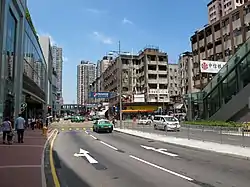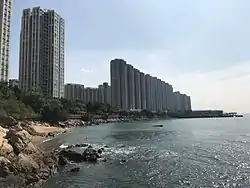Tuen Mun
Tuen Mun or Castle Peak is a satellite town near the mouth of Tuen Mun River and Castle Peak Bay in the New Territories, Hong Kong. It was one of the earliest settlements in what is now Hong Kong and can be dated to the Neolithic period.[1] In the more recent past, it was home to many Tanka fishermen who gathered at Castle Peak Bay.[2] Tuen Mun is now a modern, mainly residential area in the north-west New Territories. As of 2011, 487 546 live in Tuen Mun and over 95% of them are Chinese.[3]
| Tuen Mun | |||||||||||||||
|---|---|---|---|---|---|---|---|---|---|---|---|---|---|---|---|
 Tuen Mun | |||||||||||||||
| Traditional Chinese | 屯門 | ||||||||||||||
| Simplified Chinese | 屯门 | ||||||||||||||
| Literal meaning | Garrison Gate | ||||||||||||||
| |||||||||||||||
History
.png.webp)


During the Tang dynasty (618–907), a navy town, Tuen Mun Tsan (屯門鎮) was established in Nantou, which lies across Deep Bay. Tuen Mun and the rest of Hong Kong were under its protection.
A major clan, To (Chinese: 陶), brought the name Tuen Mun to the area. They migrated from Jiangxi on the Chinese mainland and established a village Tuen Mun Tsuen (屯門村)[4] late in the Yuan dynasty (1272–1368). As more and more villages were established, the village was renamed Tuen Mun Tai Tsuen (屯門大村), which means "large village" in Chinese. As yet more villages were established, a market town of Tuen Mun Hui (屯門墟) (now Tuen Mun Kau Hui) was established. This town lies where present-day Tuen Mun Kau Hui is situated.
Tuen Mun remained an important town of coastal defence until the start of British rule in 1898. When the British took over the New Territories from the Qing government in this year, the area was renamed Castle Peak, and Tuen Mun Hui to Castle Peak Market (青山墟) or Tsing Shan Hui. The name Tuen Mun, however, continued to be used by those living in the area.
In 1965, "Castle Peak New Town" was planned. It was later renamed Tuen Mun New Town and constructed from 1970 onwards with many buildings on the reclamed land of the former Castle Peak Bay. The name was officially changed back to Tuen Mun in 1972.[5] The first public housing estate built in the town was Castle Peak Estate, opened 1971.

Geography
Tuen Mun is located in the west of Hong Kong's New Territories. It is sandwiched between two mountains, Castle Peak (583m) from the west and Kau Keng Shan (507m) from the east.
Tuen Mun Trail contains 2 segments. One starts from Hoh Fuk Tong College in San Hui connected with the end of MacLehose Trail through to Yeuk Mung Yuen (若夢園) till Prime View Garden. Another starts from "Yeuk Mung Yuen" to Fu Tei. It opens up the hills flanking the town, seeing the broad view of picturesque Tuen Mun from the lookout points.
Facilities


There are three traditional-style markets in the town: Tuen Mun Kau Hui (屯門舊墟), Tuen Mun San Hui (屯門新墟) and Sam Shing Hui (三聖墟).
There are many government facilities also, including the Tuen Mun Magistracy, and governmental offices. Leisure facilities include several sports complexes, a multi-story central library supplemented by two others, and a theatrical and concert venue in the form of the Tuen Mun Town Hall at Tuen Mun Town Centre.
The Correctional Services Department operates the Tai Lam Centre for Women in the district.
The Chep Lap Kok airport is across the locality.

Public utilities
Hong Kong's largest electricity generation facilities, the Castle Peak Power Station (Station A & B) and Black Point Power Station (Station C), are located in western Tuen Mun.
Education
There are 36 primary and 38 secondary schools in Tuen Mun. There are three higher education institutions including Lingnan University, Hong Kong Institute of Vocational Education (IVE) and Chu Hai College of Higher Education.
Primary and secondary schools:
Transport
Light Rail

Tuen Mun is served extensively by zones 1–3 of the MTR Light Rail (zones 4, 5, 5a are in Yuen Long and Tin Shui Wai), the initial phase of which was completed and operational on 18 September 1988. The government decided that services between town centres and settlements would be provided solely by a Light Rail Transit (LRT) system, while feeder buses operated by the Kowloon-Canton Railway Corporation (now operated by MTR after the takeover in 2007) would connect remote sites to the network, replacing Kowloon Motor Bus's equivalent services where applicable. The North-west Railway, as it was then known, was thus established according to the Kowloon-Canton Railway Corporation Ordinance.
The system consisted of two big and three small loops serving most of the public housing estates in northern Tuen Mun. Three branches: one to On Ting Estate in the southeast, one to the Tuen Mun Ferry Pier in the southwest, and another northern branch all the way into the town of Yuen Long along Castle Peak Road.
MTR West Rail Line
With the West Rail Line opened on 20 December 2003 the Light Rail have also taken the role of feeder services. Tuen Mun and Hung Hom are the terminus of West Rail Line. The service had been enhanced from 8-car train to 10-car to cope with the increasing population in Tuen Mun, Tin Sui Wai, and Yuen Long. In the coming 2021. West Rail Line and Ma On Shan Line are going to be replaced by Tuen Ma Line. Passengers taking the new line can reach Ma On Shan, Kai Tak, Tai Wai and Diamond Hill District directly and conveniently.
Road
Tuen Mun is well-connected to different districts in Hong Kong and the border with the Mainland, China.
Residents can take 962 series, 960, 961 bus to the Hong Kong Island side. Meanwhile, LWB provides service between Tuen Mun and Hong Kong International Airport. KMB, one of the bus companies in HK, having route 59M,59X,60M,60X,53,263,260X,259D,62X and more to bring passenger from Tuen Mun to various destination in New Territories and Kowloon. Passengers can take A33, A33X, A33P, E33, E33P, N30, NA33, and N30P to the airport at day time, afternoon and mid-night.
The Hong Kong-Shenzhen Western Corridor, Cross Border Shuttle Services to Shekou is operated by Citybus on route B3, which departs from Tuen Mun Ferry Pier and B3X which departs from Tuen Mun Town Centre, a five minutes walk from MTR Tuen Mun Station. Residents can also take Green Minibus service 44,44A,44B to the Lok Ma Chau Border, and Lo Wu Border from Tuen Mun.
MTR bus is available within the Tuen Mun District. Routes can reach most of the residential areas in Tuen Mun. K52, K51, 506, and K53 serving from the early morning to late night. Passenger transferring to/from Light Rail(LRT) and West Rail Line could get a transit discount by using Octopus Card to pay.
Ferry
Private ferries is also available in sporadic times in the public pier, 15 minutes walk from the Tuen Mun Ferry Pier.
The town is also served by New World First Ferry services to Tung Chung (being discontinued in July 2008 and replaced by Fortune Ferry Tuen Mun – Tung Chung – Sha Lo Wan – Tai O services). On 28 January 2016, TurboJET launched the new cross-boundary ferry services between Tuen Mun, Macau and Shenzhen Airport (being suspended services since 2019 due to the COVID-19 pandemic).[6] All services departs from Tuen Mun Ferry Pier.
Climate
| Climate data for Tuen Mun (1988–2016) | |||||||||||||
|---|---|---|---|---|---|---|---|---|---|---|---|---|---|
| Month | Jan | Feb | Mar | Apr | May | Jun | Jul | Aug | Sep | Oct | Nov | Dec | Year |
| Average high °C (°F) | 19.2 (66.6) |
19.7 (67.5) |
22.1 (71.8) |
25.7 (78.3) |
29.0 (84.2) |
30.7 (87.3) |
31.7 (89.1) |
31.7 (89.1) |
31.0 (87.8) |
28.8 (83.8) |
25.3 (77.5) |
21.2 (70.2) |
26.3 (79.3) |
| Daily mean °C (°F) | 15.7 (60.3) |
16.8 (62.2) |
19.3 (66.7) |
23.0 (73.4) |
26.2 (79.2) |
28.2 (82.8) |
28.9 (84.0) |
28.7 (83.7) |
27.9 (82.2) |
25.5 (77.9) |
21.7 (71.1) |
17.5 (63.5) |
23.3 (73.9) |
| Average low °C (°F) | 13.0 (55.4) |
14.3 (57.7) |
16.9 (62.4) |
20.8 (69.4) |
24.0 (75.2) |
26.0 (78.8) |
26.6 (79.9) |
26.3 (79.3) |
25.5 (77.9) |
22.9 (73.2) |
18.9 (66.0) |
14.6 (58.3) |
20.8 (69.4) |
| Average precipitation mm (inches) | 33.4 (1.31) |
37.3 (1.47) |
55.3 (2.18) |
135.7 (5.34) |
220.4 (8.68) |
330.4 (13.01) |
255.4 (10.06) |
301.8 (11.88) |
183.6 (7.23) |
50.2 (1.98) |
43.4 (1.71) |
35.9 (1.41) |
1,682.8 (66.25) |
| Average relative humidity (%) | 70 | 75 | 76 | 79 | 78 | 80 | 77 | 78 | 74 | 68 | 67 | 65 | 73 |
| Source: Hong Kong Observatory[7] | |||||||||||||
References
- "Artefacts found in Tuen Mun in Neolithic period – Antiquities and Monuments Office". Antiquities and Monuments Office (Leisure and Cultural Services Department). Govt of Hong Kong. Retrieved 2 January 2015.
- Anderson, Eugene (2007). Floating world lost : a Hong Kong fishing community. New Orleans, LA: University Press of the South. ISBN 9781931948517.
- http://www.census2011.gov.hk/pdf/fact_sheets/DC/L00e.pdf
- Antiquities and Monuments Office: Tuen Tsz Wai - History
- (in Chinese)
- "TurboJET". www.turbojet.com.hk.
- "Extract of Annual Data – Tuen Mun, 1998–2016". Hong Kong Observatory. Retrieved 8 February 2017.
Further reading
- "Traffic Improvements to Tuen Mun Road Town Centre Section", Hong Kong Environmental Protection Department, 2007
- "Historical Background of Tuen Mun", Hong Kong Planning Department, 2002
External links
| Wikimedia Commons has media related to Tuen Mun. |
- Delineation of area of existing village Tuen Mun Kau Hui (Tuen Mun) for election of resident representative (2019 to 2022)
- Centalink Map of Tuen Mun
- Timeline of Tuen Mun's development (Chinese)
- Tuen Mun Football Team
- Aerial video of Tuen Mun Typhoon Shelter
- Item #1221. Hau Kok Tin Hau Temple, Tin Hau Road, Tuen Mun Antiquities and Monuments Office. Brief Information on No Grade Items.